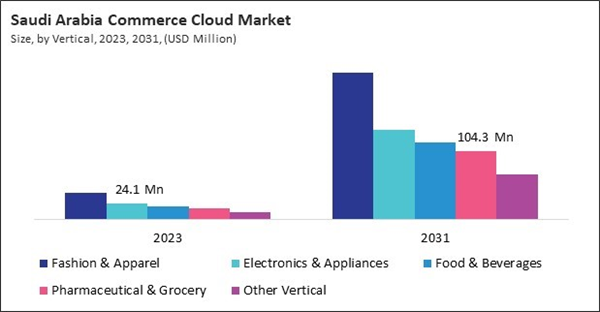The Brazil market dominated the LAMEA Commerce Cloud Market by Country in 2023, and would continue to be a dominant market till 2031; thereby, achieving a market value of $1.40 billion by 2031. The Argentina market is showcasing a CAGR of 25.1% during (2024 - 2031). Additionally, The UAE market would register a CAGR of 23.3% during (2024 - 2031).
Commerce cloud platforms enable businesses to create and manage omnichannel loyalty programs that reward customers for their interactions across all channels, including online stores, mobile apps, and physical locations. Businesses can design flexible and customizable loyalty rewards based on customer preferences, purchase frequency, and engagement levels. These rewards can include discounts, exclusive access to new products, and special promotions.
The adoption of commerce cloud solutions has seen significant growth across various industries. Several factors contribute to this widespread adoption. Commerce cloud platforms enable businesses to deliver highly personalized customer experiences at scale. Through advanced data analytics and machine learning, businesses can tailor product recommendations, marketing messages, and shopping experiences to individual customer preferences, enhancing satisfaction and loyalty.
By 2025, the Dubai Chamber of Commerce and Industry anticipates that e-commerce will generate $8 billion in sales in the UAE market. As the UAE continues to expand its role as a global trade hub, the demand for advanced commerce cloud solutions that facilitate international trade, cross-border e-commerce, and logistics management will grow. This includes solutions for handling diverse currencies, customs regulations, and international shipping requirements. Expanding the retail sector in the UAE, particularly in high-end and luxury markets, boosts the demand for commerce cloud solutions that support sophisticated e-commerce operations, including personalized customer experiences, high-volume transactions, and seamless integration with luxury brand requirements.
With the UAE’s growing emphasis on sustainability and green initiatives, there is an increasing demand for commerce cloud solutions that support sustainable practices. This includes features for managing eco-friendly supply chains, reducing carbon footprints, and supporting green certifications. Thus, the increasing food and beverage industry and growing e-commerce sector in the region promote the market's growth.
Based on Type, the market is segmented into Platform, and Services. Based on Offering, the market is segmented into Public Cloud, Hybrid Cloud, and Private Cloud. Based on Enterprise Size, the market is segmented into Large Enterprises, and SMEs. Based on Vertical, the market is segmented into Fashion & Apparel, Electronics & Appliances, Food & Beverages, Pharmaceutical & Grocery, and Other Vertical. Based on countries, the market is segmented into Brazil, Argentina, UAE, Saudi Arabia, South Africa, Nigeria, and Rest of LAMEA.
List of Key Companies Profiled
- Oracle Corporation
- com, Inc.
- IBM Corporation
- Microsoft Corporation
- SAP SE
- Shopify Inc.
- Amazon Web Services, Inc. (Amazon.com, Inc.)
- Adobe, Inc.
- Google LLC
- BigCommerce Inc.
Market Report Segmentation
By Type
- Platform
- Services
By Offering
- Public Cloud
- Hybrid Cloud
- Private Cloud
By Enterprise Size
- Large Enterprises
- SMEs
By Vertical
- Fashion & Apparel
- Electronics & Appliances
- Food & Beverages
- Pharmaceutical & Grocery
- Other Vertical
By Country
- Brazil
- Argentina
- UAE
- Saudi Arabia
- South Africa
- Nigeria
- Rest of LAMEA
Table of Contents
Companies Mentioned
- Oracle Corporation
- Salesforce.com, Inc.
- IBM Corporation
- Microsoft Corporation
- SAP SE
- Shopify Inc.
- Amazon Web Services, Inc. (Amazon.com, Inc.)
- Adobe, Inc.
- Google LLC
- BigCommerce Inc.
Methodology

LOADING...









